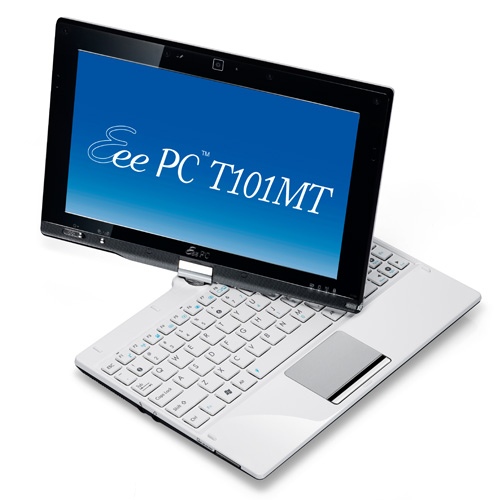Problemi in questa pagina? Segnalali in questa discussione
In questa pagina sono riportati il resoconto dell'installazione di Ubuntu e le informazioni sul riconoscimento hardware del portatile ASUS T101mt. |
|
|
Marca: |
Asus |
Modello: |
T101mt |
Memoria RAM: |
2 GiB |
Processore: |
Intel ATOM N450 |
Scheda video: |
Intel N10 |
Schermo: |
10.1" |
Installazione
Rilevamento dell'hardware
Dispositivi connessi
Per verificare il corretto rilevamento dell'hardware del portatile, digitare in un terminale il seguente comando:
lspci
Il comando precedente restituirà una schermata simile alla seguente:
00:00.0 Host bridge: Intel Corporation N10 Family DMI Bridge 00:02.0 VGA compatible controller: Intel Corporation N10 Family Integrated Graphics Controller 00:02.1 Display controller: Intel Corporation N10 Family Integrated Graphics Controller 00:1b.0 Audio device: Intel Corporation N10/ICH 7 Family High Definition Audio Controller (rev 02) 00:1c.0 PCI bridge: Intel Corporation N10/ICH 7 Family PCI Express Port 1 (rev 02) 00:1c.1 PCI bridge: Intel Corporation N10/ICH 7 Family PCI Express Port 2 (rev 02) 00:1c.3 PCI bridge: Intel Corporation N10/ICH 7 Family PCI Express Port 4 (rev 02) 00:1d.0 USB Controller: Intel Corporation N10/ICH 7 Family USB UHCI Controller #1 (rev 02) 00:1d.1 USB Controller: Intel Corporation N10/ICH 7 Family USB UHCI Controller #2 (rev 02) 00:1d.2 USB Controller: Intel Corporation N10/ICH 7 Family USB UHCI Controller #3 (rev 02) 00:1d.3 USB Controller: Intel Corporation N10/ICH 7 Family USB UHCI Controller #4 (rev 02) 00:1d.7 USB Controller: Intel Corporation N10/ICH 7 Family USB2 EHCI Controller (rev 02) 00:1e.0 PCI bridge: Intel Corporation 82801 Mobile PCI Bridge (rev e2) 00:1f.0 ISA bridge: Intel Corporation NM10 Family LPC Controller (rev 02) 00:1f.2 SATA controller: Intel Corporation N10/ICH7 Family SATA AHCI Controller (rev 02) 01:00.0 Ethernet controller: Atheros Communications AR8132 Fast Ethernet (rev c0) 02:00.0 Network controller: Atheros Communications Inc. AR9285 Wireless Network Adapter (PCI-Express) (rev 01)
Processore
Per visualizzare i dettagli sul processore, aprire in lettura il file /proc/cpuinfo, digitando in una finestra di terminale il seguente comando:
cat /proc/cpuinfo
Il risultato sarà simile al seguente:
processor : 0 vendor_id : GenuineIntel cpu family : 6 model : 28 model name : Intel(R) Atom(TM) CPU N450 @ 1.66GHz stepping : 10 cpu MHz : 1000.000 cache size : 512 KB physical id : 0 siblings : 2 core id : 0 cpu cores : 1 apicid : 0 initial apicid : 0 fdiv_bug : no hlt_bug : no f00f_bug : no coma_bug : no fpu : yes fpu_exception : yes cpuid level : 10 wp : yes flags : fpu vme de pse tsc msr pae mce cx8 apic mtrr pge mca cmov pat clflush dts acpi mmx fxsr sse sse2 ss ht tm pbe nx lm constant_tsc arch_perfmon pebs bts aperfmperf pni dtes64 monitor ds_cpl est tm2 ssse3 cx16 xtpr pdcm movbe lahf_lm dts bogomips : 3325.02 clflush size : 64 cache_alignment : 64 address sizes : 32 bits physical, 48 bits virtual power management: processor : 1 vendor_id : GenuineIntel cpu family : 6 model : 28 model name : Intel(R) Atom(TM) CPU N450 @ 1.66GHz stepping : 10 cpu MHz : 1000.000 cache size : 512 KB physical id : 0 siblings : 2 core id : 0 cpu cores : 1 apicid : 1 initial apicid : 1 fdiv_bug : no hlt_bug : no f00f_bug : no coma_bug : no fpu : yes fpu_exception : yes cpuid level : 10 wp : yes flags : fpu vme de pse tsc msr pae mce cx8 apic mtrr pge mca cmov pat clflush dts acpi mmx fxsr sse sse2 ss ht tm pbe nx lm constant_tsc arch_perfmon pebs bts aperfmperf pni dtes64 monitor ds_cpl est tm2 ssse3 cx16 xtpr pdcm movbe lahf_lm dts bogomips : 3324.97 clflush size : 64 cache_alignment : 64 address sizes : 32 bits physical, 48 bits virtual power management:
Configurazione dei componenti
Sono stati sviluppati da un utente del forum internazionale alcuni utilissimi pacchetti che migliorano la gestione generale del notebook. Tali pacchetti modificano parzialmente le politiche di risparmio energetico e forniscono altre utili funzionalità, soprattutto per il touchscreen.
Aggiungere il repository dedicato digitando il seguente comando in una finestra di terminale:
sudo apt-add-repository ppa:plippo/t101mt && sudo apt-get update && sudo apt-get upgrade
Installare i pacchetti digitando il seguente comando:
sudo apt-get install eeepc-acpi-workaround egalax-multitouch-driver-common eeepc-brightness-workaround eeepc-powersave
Scheda video
Riconosciuta automaticamente ![]()
Scheda audio
Riconosciuta automaticamente ![]()
Interfacce di rete
Riconosciute automaticamente ![]()
Touchpad
Riconosciuto automaticamente ![]()
La funzione di scroll a due dita è attivabile modificando le impostazioni del touchpad dalla finestra di gestione del Mouse. |
Tasti rapidi
Riconosciuti automaticamente ![]()
Bluetooth
Riconosciuto automaticamente ![]()
Touchscreen
Il netbook in oggetto viene distribuito con due differenti versioni del touchscreen.
Per verificare quale tra queste equipaggia il proprio computer procedere come segue:
Digitare in una finestra di terminaleil seguente comando:
lsusb
il risultato, nel caso si possegga un netbook con touchscreen di prima generazione, sarà:
Bus 003 Device 003: ID 0eef:480d D-WAV Scientific Co., Ltd
questa versione dell'hardware viene automaticamente riconosciuta da Ubuntu 11.04.
Qualora il risultato del comando lsusb fosse:
0486:0186 ASUS Computers, Inc.
vuol dire che si possiede un hardware touchscreen di seconda generazione. Si rimanda al Wiki internazionale per le problematiche relative a questa versione.
Informazioni aggiuntive
Per informazioni dettagliate sull'utilizzo del TouchScreen e sulla risoluzione dei problemi connessi all'utilizzo del netbook, consultare la : seguente pagina.

